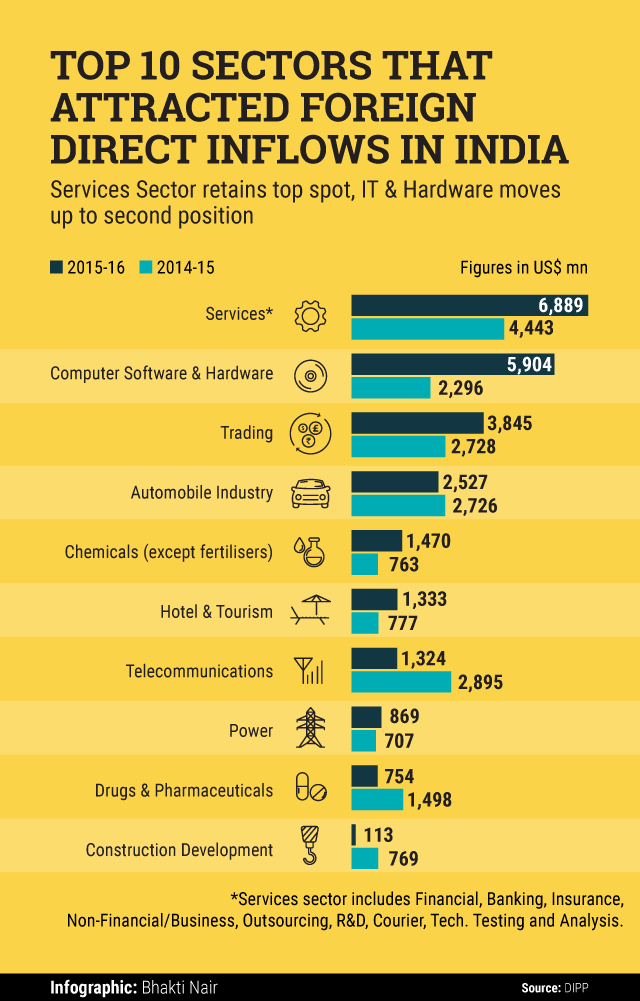In a move that marks a radical shift in India's foreign investment policy so far, the Union government, on Monday, liberalized the foreign direct investment (FDI) regime with the objective of providing major push to employment and job creation in the country.
The FDI regulations were relaxed in all major sectors of the economy including civil aviation, defence, food and single brand retail, pharma, airports, cable distribution and DTH services. The move makes India the most open economy in the world for FDI.
This is the second time since the Narendra Modi government assumed power a little over two years ago, that it has relaxed FDI norms. It even sought to attract FDI in the manufacturing sector via its flagship ‘Make in India’ program, which has already been credited with bringing in record levels of foreign investment into the country.
FDI equity inflow has undoubtedly swelled since Modi came to power. An analysis of the data, released by the commerce ministry, however, shows that ‘Make in India’ has, so far, had little to contribute to the upswing.

The data show that a bulk of the $40 billion that India attracted by way of FDI during the financial year 2015-16, did not go into manufacturing, thereby putting a question mark over the efficacy of the ‘Make in India’ initiative. The data show that during 2015-16, the first full financial year of the Modi government, three non-manufacturing sectors - services, computer software and hardware, and trading - attracted more than 41.5% of the FDI inflow, whereas core manufacturing sectors such as automobiles, chemicals, power, pharma and construction got only 14% of the FDI.
The data further show that apart from the aforementioned non-manufacturing sectors, hotels and tourism and telecommunications were the others areas that saw foreign investors pumping in money.

In comparison, during the financial year 2014-15, India had received nearly $31 billion in FDI. Out of this, services, computer software and hardware and trading together received 30% of the total inflow whereas the core manufacturing sectors accounted for only 21% of the investment flowing in. This, however, was much higher a share when compared with 2015-16.
FDI into each of the three key manufacturing sectors actually registered a sharp decline in 2015-16 vis-a-vis 2014-15. Inflows into the automobile industry, for instance, fell from a little over $2.7 billion to $2.5 billion in the aforementioned period. The pharma and construction sectors saw even sharper falls. While foreign investments into pharma companies nearly halved, the construction sector attracted less than a sixth of foreign money in 2015-16, as compared to the previous year.
To be sure, this data capture investment only into the top 10 sectors that attracted foreign inflows. However, since these 10 sectors account for more than 60% of the total FDI inflow, investment into the other sectors, taken individually, will be comparatively negligible, and is, therefore, unlikely to upset the trend.
With the twin objectives of ramping up domestic production and substituting imports, the Modi government in September 2014, had launched the ‘Make in India’ programme, which aimed at creating jobs and develop a skilled workforce across 25 sectors of the Indian economy. Some of the sectors that the initiative targets include - mining, aviation, biotechnology, chemicals and defence.

In April 2015, a little over six months after ‘Make in India’ was launched, the government said in a release that FDI inflow had gone up by 48% over the corresponding period during the previous year. “In 2014-15, (the) country witnessed unprecedented growth of 717 percent, to US $ 40.92 billion of Investment by Foreign Institutional Investors (FIIs). The FDI inflow under the approval route saw a growth of 87% during 2014-15 with inflow of US$ 2.22 billion despite more sectors having been liberalized during this period and with more than 90 percent of FDI being on automatic route,†the government had said, adding that the increased inflow, “especially in a climate of contracting worldwide investments indicates the faith that overseas investors have imposed in the country's economy and the reforms initiated by the government towards ease of doing business.â€
In December 2015, The Financial Times reported that FDI inflows in India, during the first half of 2015 had topped $31 billion, surpassing both the US and China. Again, in February this year, the annual pre-budget Economic Survey said that FDI inflows had risen 40% between October 2014 and June 2015.
In fact, several economists including the Reserve Bank of India governor Raghuram Rajan have been critical of ‘Make in India’. In December 2014, he said that an import substitution strategy or an incentive driven export led growth mechanism will not work for India.

N R Bhanumurthy, a professor at the New Delhi based National Institute of Public Finance and Policy (NIPFP) says that for Make in India to attract greater levels of foreign investment, the Modi government needs to do more by way of overhauling labour and land acquisition laws in the country. “I agree with Rajan, this cannot be a strategy for import substitution,†Bhanumurthy told VCCircle over the phone. “State governments need to look into these issues. Having said that, overall, there is a sense of optimism, since the ease of doing business seems to be improving. My view is that things will be better next year,†he added.
Like this report? Sign up for our daily newsletter to get our top reports.







